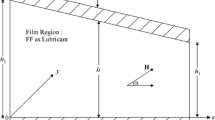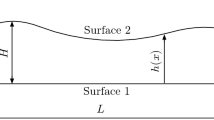Abstract
In the present paper, a multi-linearity method is used to address the nonlinear slip control equation for the hydrodynamic analysis of a two-dimensional (2-D) slip gap flow. Numerical analysis of a finite length slider bearing with wall slip shows that the surface limiting shear stress exerts complicated influences on the hydrodynamic behavior of the gap flow. If the slip occurs at either the stationary surface or the moving surface (especially at the stationary surface), there is a transition point in the initial limiting shear stress for the proportional coefficient to affect the hydrodynamic load support in two opposite ways: it increases the hydrodynamic load support at higher initial limiting shear stresses, but decreases the hydrodynamic load support at lower initial limiting shear stresses. If the slip occurs at the moving surface only, no fluid pressure is generated in the case of null initial limiting shear stress. If the slip occurs at both the surfaces with the same slip property, the hydrodynamic load support goes off after a critical sliding speed is reached. A small initial limiting shear stress and a small proportionality coefficient always give rise to a low friction drag.
Similar content being viewed by others
References
Craig V.S.J. and Neto C. (2001). Williams D.R.M.: shear-dependent boundary slip in an aqueous Newtonian liquid. Phys. Rev. Lett. 87(5): 054504
Zhu Y. and Granick S. (2001). Rate-dependent slip of Newtonian liquid at smooth surfaces. Phys. Rev. Lett. 87(9): 096105
Zhu Y. and Granick S. (2002). Limits of the Hydrodynamic no-slip boundary condition. Phys. Rev. Lett. 88(10): 106102
Hervet H. and Léger L. (2003). Flow with slip at the wall: from simple to complex fluids. C. R. Physique 4(2): 241–249
Thompson P.A. and Troian S.M. (1997). A general boundary condition for liquid flow at solid surfaces. Nature 389: 360–362
Priezjev N.V. and Troian S.M. (2004). Molecular origin and dynamic behavior of slip in sheared polymer films. Phys. Rev. Lett. 92(1): 018302
Nagayama G. and Cheng P. (2004). Effects of interface wettability on microscale flow by molecular dynamic simulation. Int. J. Heat Mass Transf. 47: 501–513
Neto C., Evans D.R. and Craig V.S.J. (2005). Boundary slip in Newtonian liquids: a review of experimental studies. Rep. Prog. Phys. 68: 2859–2897
Navier C.L.M.H. (1823). Mémoire sur les lois du mouvement des fluides. Mém l’Acad R. Sci. l’Inst France 6: 389–440
Smith F.W. (1959). Lubricant behavior in concentrated contact systems-the castor oil-stell system. Wear 2: 250–263
Bair S. and Winer W.O. (1979). Shear strength measurements of lubricants at high pressure. ASME J. Lubr. Tech. 101: 251–256
Wu C.W. and Ma G.J. (2005). On the boundary slip of fluid flow. Sci. China Ser. G 48(2): 178–187
Spikes H.A. and Granick S. (2003). Equation for slip of simple liquids at smooth solid surfaces. Langmuir 19: 5065–5071
Salant R.F. and Fortier A.E. (2004). Numerical analysis of a slider bearing with a heterogeneous slip/no-slip surface. Tribol. Trans. 47: 328–334
Maxwell J.C. (1879). On stresses in rarefied gases arising from inequalities of temperature. Philos. Trans. R. Soc. 170: 231–256
Peng Y.Q., Lu X.C. and Luo J.B. (2004). Nanoscale effect on ultrathin gas film lubrication in hard disk drive. ASME J. Tribol. 126: 347–352
Wu C.W. and Sun H.X. (2006). Quadratic programming algorithm for wall slip and free boundary pressure condition. Int. J. Numer. Methods Fluids 50: 131–145
Spikes H.A. (2003). The half-wetted bearing. Part 1: extended Reynolds equation. Proc. Inst. Mech. Eng. Part J J. Eng. Tribol. 217: 1–14
Jacobson B.O. and Hamrock B.J. (1984). Non-Newtonian fluid model incorporated into elastohydrodynamic lubrication of rectangular contacts. ASME J. Tribol. 106: 275–282
Stahl J. and Jacobson B.O. (2003). A lubricant model considering wall-slip in EHL line contacts. ASME J. Tribol. 125: 523–532
Wilson W.R.D. and Huang X.B. (1989). Viscoplastic behavior of a silicone oil in a metalforming inlet zone. ASME J. Tribol. 111: 585–590
Östensen J.O., Wikström V. and Höglund E. (1993). Interaction effects between temperature, pressure and type of base oil on lubricant shear strength coefficient. Tribologia Finnish J. Tribol. 11(4): 123–132
Wikström V. and Höglund E. (1994). Investigation of parameter affecting the limiting shear stress-pressure coefficient: a new model incorporating temperature. ASME J. Tribol. 116: 612–620
Zhang H.W. and Zhang X.W. (2002). A combined parametric quadratic programming and precise integration method based dynamic analysis of elastic-plastic hardening/softening problems. Acta Mech. Sin. 18(6): 638–648
Author information
Authors and Affiliations
Corresponding author
Additional information
The project supported by the National Natural Science Foundation of China (10421002, 10332010), the National Basic Research Program of China (2006CB601205), and the Science Research Foundation of Liaoning Province (20052178).
The English text was polished by Yunming Chen.
Rights and permissions
About this article
Cite this article
Ma, G.J., Wu, C.W. & Zhou, P. Influence of wall slip on the hydrodynamic behavior of a two-dimensional slider bearing. Acta Mech. Sin. 23, 655–661 (2007). https://doi.org/10.1007/s10409-007-0099-9
Received:
Revised:
Accepted:
Published:
Issue Date:
DOI: https://doi.org/10.1007/s10409-007-0099-9




